

Paludariums differ from aquariums and terrariums in that they offer both land, water, and air for animals to live in. This means that almost any species of animal has the potential to live in a paludarium, depending on the specific design and type of ecosystem the creator is trying to reproduce. But most often they will house fish, amphibians, crustaceans, reptiles, or insects. I have even heard of people keeping birds and spiders inside paludariums, although this is far from typical. Most animals for a paludarium installation will have some requirement for land and water, or at least a strong need for moisture. Usually they will include at least one species that is semi aquatic, usually amphibians, reptiles or fish. Common paludarium animals include mudskippers, killifish, guppies, poison dart frogs, tree frogs, toads, newts, salamanders and small turtles.
The difficult part is creating a balanced ecosystem that is perfect for all paludarium inhabitants, both creatures and plants. Everything must be just right: temperature, humidity, lighting, and filtration. Furthermore, tankmates must be compatible. Make sure you don't house carnivorous species with other animals. Many paludarium species will eat anything that they can get their teeth into. You must do your research on each animal if you plan to include more than one species, or even more than one individual. Territorial species may fight (and kill) each other, and some animals are happily cannibalistic. Make sure reptiles and amphibians, for example, do not eat the fish! As a general rule, a species paludarium (i.e. an installation that houses just one species) is the most likely to be successful, with room for individual paludarium inhabitants to have their own space to thrive.
Some of the paludarium species most often seen for sale
Frogs and toads are perhaps the most obvious candidate for the paludarium, but all amphibians are perfectly suited to the moisture of a water's edge biome.
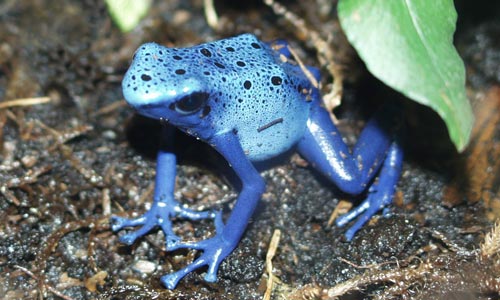
There are numerous poison dart frog species, and all are excellent candidates for a paludarium. Their name is misleading: they are not poisonous (in captivity) and neither are they frogs (they're toads). But they are usually very brightly coloured and amazing animals to watch. They spend the vast majority of their time on land, though some species may paddle in the shallow, or even jump into water to hide if scared. There are two broad types of dart frog. The larger terrestrial species that spend most of their time on the tank floor, or lowest leaves and branches; and then there are the smaller 'thumbnail' species that inhabit the leaves (often resting in the axials of bromeliads) higher up the tank.
These wonderful rainforest frogs make an excellent addition to a well-planted Amazon-styled paludarium, and are often kept with orchids or other delicate tropical plant species. Generally the larger species are easiest to keep. Look out for Dendrobates tinctorius, Dendrobates auratus and Dendrobates leucomelas. Dart frogs are not strong swimmers, so make sure if one falls into the water it can easily get out. Generally, unless fish are also in the tank, a few inches of water is completely adequate. Some killifish are quite used to living in small bodies of water, and consequently make great tankmates. One of my favorite installations included two Colombian rainforest species together: dart frogs of the species Dendrobates truncatus living alongside a medium sized killifish Rivulus magdalenae both species that come from the Magdalena River basin.
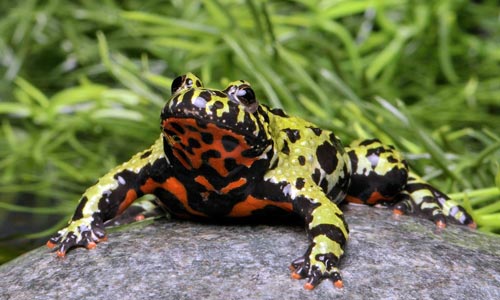 Photo Flickpickpete
Photo FlickpickpeteIt's obvious how the fire-bellied toad gets it's name. In contrast to the poison dart frog above, the fire-bellied toad is not a toad but actually a frog. These frogs do produce a mild toxin, and although not deadly, you should certainly wash thoroughly after working on their tank. For this reason, they should generally not be kept with other species that will come into contact with them.
Fire bellied toads are active, relatively easy to keep species that enjoy water and land, spending time in both, but are most often seen splashing around the boundary where the two meet. They are hardy frogs, and are well-known in the pet trade. They inhabit warm forest streams in China and Korea, so do enjoy a well planted tank. Make sure there are plenty of places that the frogs can use to get in and out. Fire-bellied toads should be fed crickets, earthworms and other arthropods, though the do have trouble digesting mealworms.
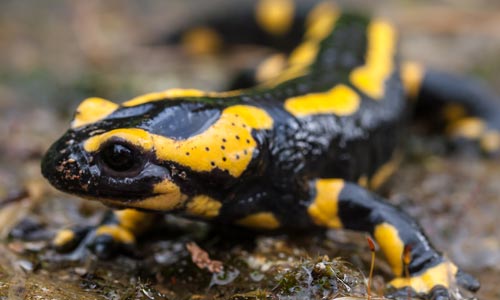 Fire salamander. Photo William Warby
Fire salamander. Photo William WarbySalamanders are a less-known amphibian species, with quite some variation in the group. Some are purely aquatic (Axolotl), some are semi-aquatic, and some are purely terrestrial. They breathe though their skin, which requires them to be kept in a moist environment. A paludarium set up should have shallow water, plenty of land, and easy access into and out of the water. The tank should be decorated with mosses, leaf litter, pieces of wood and bark, offering plenty of moisture, and plenty of hiding places. They are easy to feed, enjoying small insects, slugs and other live foods.
Salamanders are sensitive, often shy animals, that generally come out to feed during the night. Consequently, although perfect animals for a paludarium, they may not make the best of pets. They should not be handled, as chemicals on your skin (even soap residues) can seriously harm them. All salamanders are endangered in the wild, so ensure your salamander comes from captive bred stock. Keeping wild caught salamanders is a terrible idea, and possibly illegal.
Read more about Salamander care in Peter Heathcote's Salamanders.
Any fish that can be kept in a aquarium of the size offered will do just as well in a paludarium. Assuming, of course that other inhabitants are not predatory, of course. Turtles and amphibians may well eat fish. Common fish types well-suited to the paludarium are livebearers (particularly good for brackish water tanks), killifish (particularly good in smaller bodies of water), catfish, and dwarf cichlids. Of course, the best paludarium fish species are those that exhibit a behaviour that in some way involves land, i.e. mudskippers and archerfish.
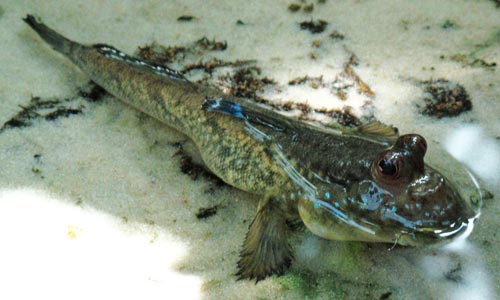 Photo Greg Goebel
Photo Greg GoebelMudskippers are very interesting fish, and because they can walk out of water with their fins, and breathe air through their skin, they make excellent pets for the paludarium, enjoying the shallows of a gradually sloped beach-style tank. Their natural habitat is mangrove swamp, and mudflats, so a paludarium with brackish water and mangrove roots is perfect. A gentle gradient out of the water perfectly replicates a beach environment, and allows the fish to easily transition from water to land. Mudskippers can be kept with other similar sized fish species, but they will eat anything smaller that they can fit in their mouths.
Gobies and particularly archerfish are suitable tankmates for similarly sized mudskippers. Dwarf mudskippers (Periophthalmus novemradiatus) stay small and will do well with commonly available livebearers. Read more about mudskipper care here.
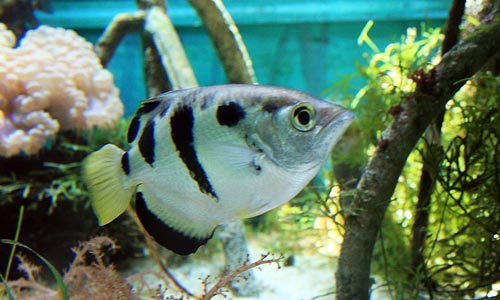 Photo Feline Groovy
Photo Feline GroovyBanded archerfish (Toxotes jaculatrix) and the larger seven-spot archerfish (Toxotes chatareus) make excellent subjects for the paludaria. They do eat crabs, fish and vegetable matter that falls into the water, but they get their name from their amazing ability to shoot water upwards, knocking prey items off of branches and leaves up to two meters away. They will also jump out of the water and catch prey if near enough. This behaviour is incredible to watch, and something that can not be replicated in an aquarium. In the paludarium, with significant space above the water, a piece of wood can be suspended above the surface. When a live cricket is placed upon it, the archerfish will shoot it off and devour it once it hits the water's surface. The archerfish habitat is a brackish water mangrove swamp, naturally similar to the mudskippers above. These two species will do well together as long as they remain of similar sizes. If either gets too big there is the danger of predation. Furthermore, both species feed in their own unique ways. Make sure both get adequate food.
Naturally, archerfish should not be kept with any land animal that you don't want eaten.
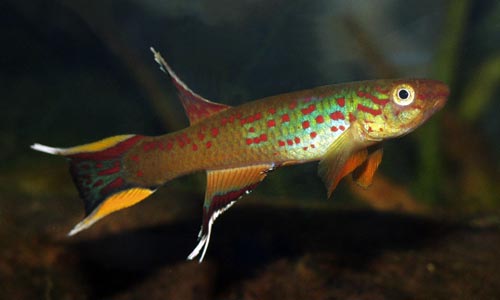
Killifish are often very brightly colored and are quite at home in small bodies of water. There are stories of some species being found in water-filled elephant footprints. Whilst possible this is probably not the best environment. However they do tolerate considerably smaller tanks than many fish. Killies are generally considered hard to keep species, in part due to their aggressive natures and requirements of live food. There are very many species, and these drawbacks are certainly not common to all species. Many are rainforest species and enjoy the relative darkness of water shaded by numerous plant leaves above. A few killies kept in a rainforest style paludarium will do well, as long as nothing is allowed to predate them. Any livefoods that fall in will be eaten, and in a dark dark with hiding places, many species will reproduce, especially if given an occasional feeding of newly hatched artemia nauplii. South American Rivulus often flip out of the water and lie on the moist bank, perhaps in search of food? In aquaria they will sometimes stick themselves to the glass just above the water level. It has been observed that wild Rivulus will travel some distance across (moist) land to find new pools in which to live. This behaviour can be quite interesting to watch, though they will generally jump back in to their pool if someone approaches their tank. Other good species include members of the following genera: Aphyosemion, Scriptayphosemion, and Pseudoepiplatys.
You can find plenty of good killifish information here
Smaller turtle species like mud turtles and musk turtles are very much at home in an appropriately decorated paludarium.
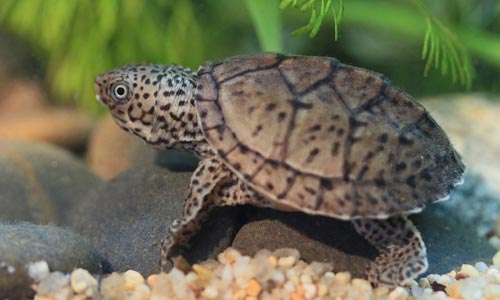 Photo Laurent Lebois
Photo Laurent LeboisSmall turtles such as the Loggerhead musk turtle Sternotherus minor need a paludarium in order to thrive. Although spending much time submerged, they do need to get out of the water from time to time, often to sleep. Turtles are carnivorous and will eat anything they can catch, including fish tankmates. A turtle paludarium needs to be large, offer excellent filtration, and UVB lighting.
Turtles grow large, and can live for a very long time (decades) so consider carefully whether you should purchase one. Released non-native animals are causing problems the world over. Read more about turtle care in Hartmut Wilkes Turtles
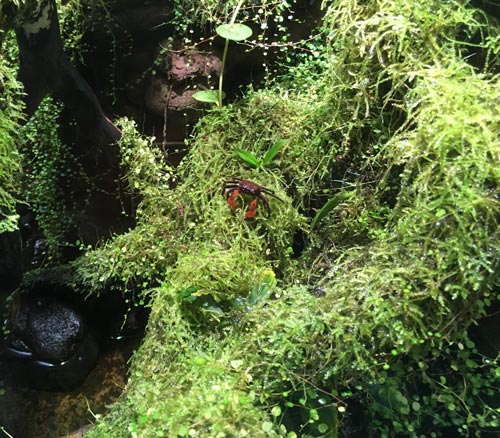
Freshwater and brackish crabs are both possible paludarium animals. Fully terrestrial species can also work well. Fiddler crabs, mandarin crabs and vampire crabs (Geosesarma) are all gaining in popularity with paludarium keepers. Naturally, high humidity is important: lush cushions of Java Moss keep moisture levels high, and form an attractive, and easy to climb cover for piles of bogwood.
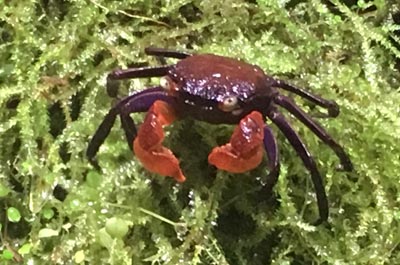
One of the few books on keeping crabs in captivity is Fiddler Crabs & Fiddler Crab Care by Alex Halton.
When you mix species you are inviting problems, maybe even resulting in the death of the animals you are trying to keep. Perhaps from a toxin produced, from introduced pathogens, an inappropriate environment for one of the species or worst of all carnivorous behaviour. But some mixtures do work very well and can be satisfying when got right. A great example is the Amazon rainforest-style paludarium where small killifish live in the water of a dart frog paludarium. These fish match the frogs in coloration and like nothing better than to pick off the odd fruit fly that has escaped the frogs and fallen into the water. Throw in some thumbnail orchids, and the explosions of color against the green of the rainforest is complete.
Another good mix is archerfish with mudskippers. Do make sure both are of similar sizes. If one outgrows the other, the smaller fish will most likely become lunch.
Mixing turtles with fish is likely to end badly. Although the fish may not be immediately eaten, they will eventually get picked off.
The animals that you can contain in your paludarium will depend on the size of the tank, obviously bigger animals need more room to live and if you want to have multiple animals you will need more room for each animal to have its own space. The above example works because the killifish and frogs will probably never come into contact with each other. When species are forced to interact, problems are far more likely.
The best bet is to stick to one species per set-up. Ensure you research the conditions that each species enjoys and the behaviour they might display in nature and in captivity. Plan the tank conditions around that one animal, giving adequate attention to temperature, humidity and feeding. Once the main inhabitant(s) are happy, you may experiment with other plant or animal species, but do look out for signs of stress. Remember the best tank mates are ones that rarely come into contact with each other! Your pet is ultimately your responsibility. It depends entirely on you for all of it's needs. Buy captive bred stock, from knowledgeable dealers, and NEVER buy a paludarium animal on impulse.
Have you got a good suggestion for a paludarium animal? Do you keep something interesting yourself? Please tell us all about it... comment
This wonderful 3 foot wide tank has a waterproof glass bottom, and adequate front window ventilation to keep the front glass clear. Although marketed as a Terrarium, it works as the perfect Paludarium. Front-opening doors, and removeable top for easy access and effective maintenance. Available in a wide range of sizes: with a larger surface area for ground/water dwelling species, or taller for leaf dwellers. Suitable for just about any paludarium inhabitant.
The top is equipped with closable inlets on both sides - this allows access for wires and tubing without offering an escape route for paludarium animals or the tiny invertebrates with which they are being fed. Suitable for powering Heat Wave rocks, waterfalls, filters and sensors, or injecting water through misting systems, external canister filters, etc.
All in all a great enclosure, providing a perfect environment for plants and animals, yet easy maintenance for the paludarium keeper. Available from Amazon and other good pet stores.